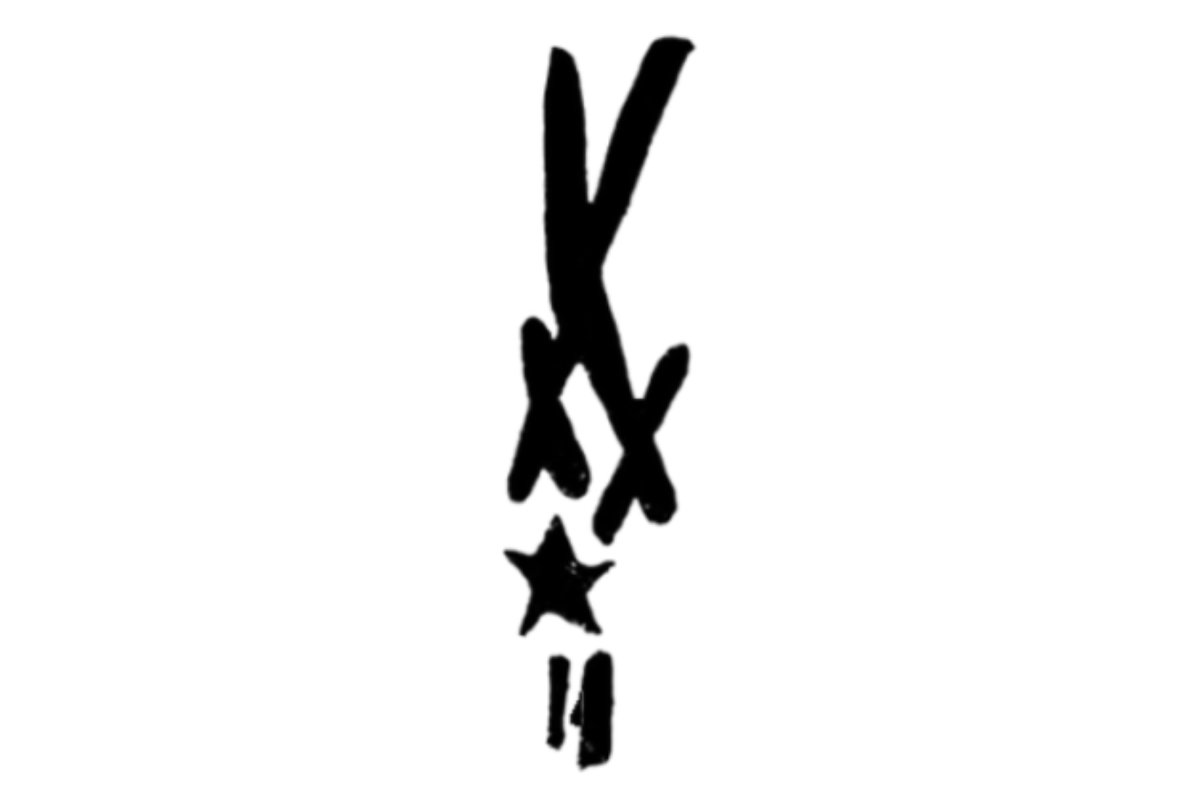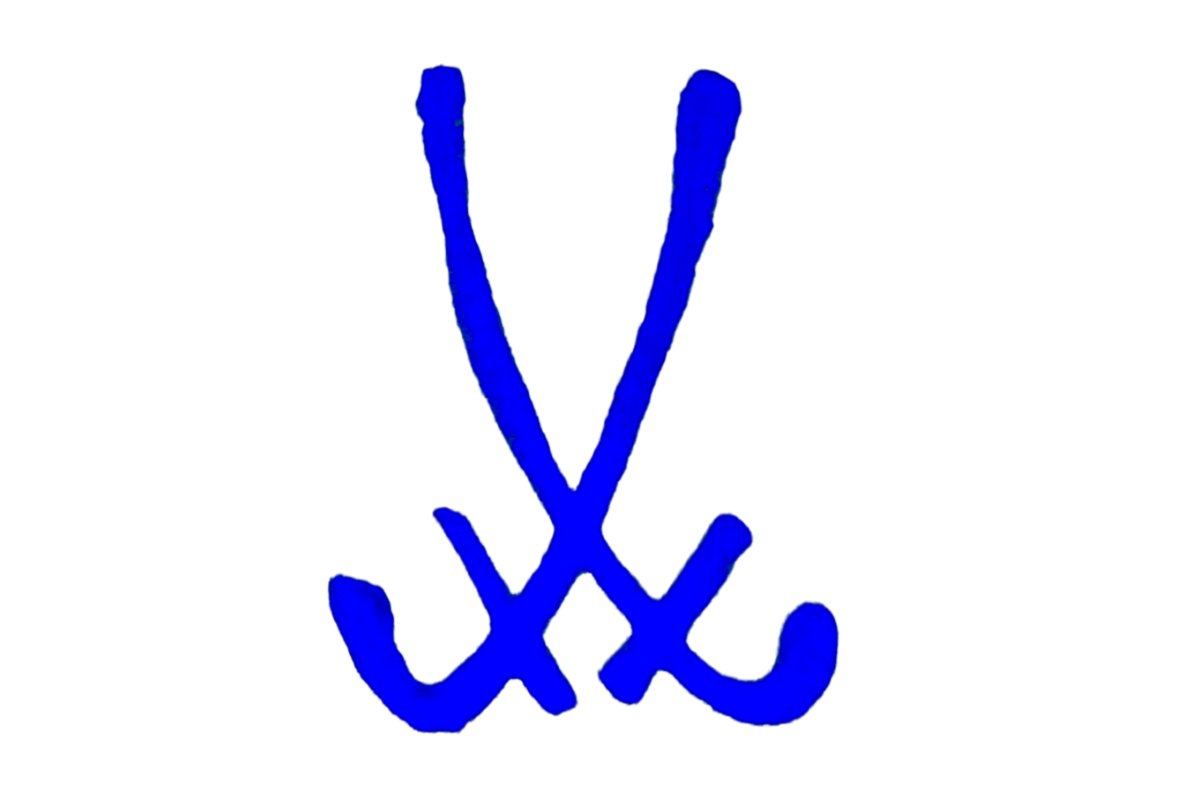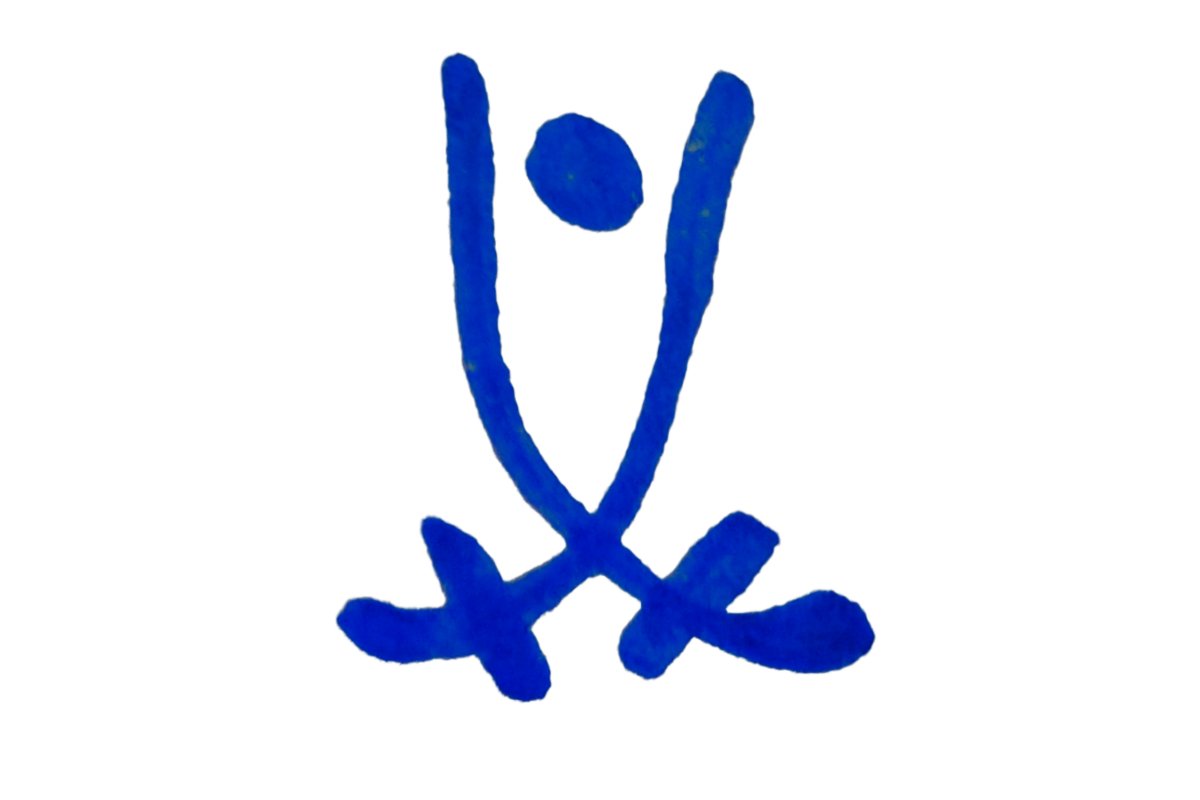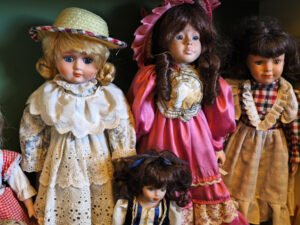Meissen Porcelain is one of the most valuable vintage European ceramics. In September, a Meissen Armorial Tea & Coffee Service Set won at Sotheby’s Auctions for over $1.3 million; no wonder every pottery collector wants it on their shelves.
If you, too, want to spot such an authentic and valuable Meissen piece, this guide is what you need! You’ll learn about Meissen porcelain crossed swords marks, model numbers, monograms, and more, and how to value the marked porcelain.
Key Takeaways
- The 1725 – 1974 Meissen porcelain ware has a national crossed swords mark derived from the Elector Symbol of the State of Saxony.
- The pre-1720s Meissen pottery features ruler and workshop monograms, often with a blue, underglaze textual logo on the base.
- All Meissen porcelain marks aren’t blue; some rare ones also have underglaze red or black underglaze.
- Marked Meissen porcelain in good condition with intricate decoration and painting and rare shape can be worth several thousands of dollars.
History of Meissen Porcelain Company
Meissen Porcelain was the first hard paste porcelain to rise and popularize in Europe. From its anticipation in 1709 to the present day, let’s take a look at Meissen Porcelain Company’s history:
- 1709: King Augustus II of Poland laid the roots of the ‘Royal-Polish and Electoral-Saxon Porcelain Manufactory’ (the Meissen factory) with his chemist Johann Friedrich Böttger. The company made red Jaspis porcelain pots, vases, and medals.
- 1713: Meissen started the production of white, ‘kaolin porcelain.’ Later, Johann Gregorius Höroldt introduced colored, enameled, and overglazed designs, too.
- 1717 – 1725: During this period, Meissen introduced its first marks! The earliest marks were simple artist monograms – AR, MPM & KPF. Then, in 1722, Meissen shifted to the crossed arms logo, based on the Roman Elector of Saxony symbol.
- 1730 – 1800s: Meissen produced over 200 million porcelain pieces, including large-scale, miniature, and Rococo figurines, under Johann Joachim Kändler.
- 1930s-1940s: The State of Saxony banned progressive Meissen artists like Ernst Barlach as per Germany’s contemporary indoctrination act. The Soviet Union confiscated the Meissen factory and equipment for war reparations in 1942.
- 1950s: Meissen workers restored their factory using their old kilns and became a joint stock company under the Soviet Union. Later, in 1950, the German Democratic Republic seized the company and renamed it the VEB Meissen Porzellan.
Today, the State of Saxony owns Meissen porcelain, and the state government funds the production of all the Meissen figurines, vases, plates, and bowls we see today!
Identifying Valuable Meissen Porcelain Marks

The post-1720s Meissen pottery had many marks on the base or the inner walls for age, artist, location, or quality. Most of these marks were blue, but some rare ones had a red or black underglaze, depending on the location and artist!
Also, such marks used underglaze transfer printing techniques, in which Meissen factory makers would dip a wooden stamp in cobalt blue pigment and impress it onto the porcelain. So, you’ll find REAL Meissen marks to be raised, uneven, and rounder than others.
Now, as I said above, you will find different types of marks on Meissen pottery. So, let’s learn about all of them.
1. Meissen Company Marks
A Meissen factory mark is not just a sign of an authentic piece; it also tells a lot about the manufacturing date and helps you find its age.
Meissen Company’s first brand mark was the cross-swords mark, which was proposed by Johann Melchior Steinbrück in 1722 and used in 1725. These marks were generally stamped during porcelain making when the piece was still leather-soft.
From 1725 to 1973, Meissen introduced a whole series of crossed swords marks, each with unique design elements that will help you date the porcelain. Let’s check these marks in this hand-drawn Meissen factory mark chart!
| Manufacturing Years | Meissen Marks | Estimated Age |
| 1725 – 1732 |  | 290 – 300 years |
| 1732 – 1773 |  | 250 – 290 years |
| 1773 – 1814 |  | 205 – 250 years |
| 1774 – 1814 (White Porcelain Mark) |  | 204 – 250 years |
| 1774 |  | Over 250 years |
| 1814 (Incised White Porcelain Mark) |  | Around 209 years |
| 1814 – 1824 |  | 209 – 219 years |
| 1825 – 1924 |  | 90 – 200 years |
| 1900 (White Porcelain Mark) |  | Around 123 years |
| 1919 (Meissen Trademark) |  | Over 100 years |
| 1924 – 1934 |  | 89 – 99 years |
| 1945 – 1947 |  | 75 – 78 years |
| 1947 – 1973 |  | 50 – 75 years |
| 1972 |  | Around 50 years |
| 1974 |  | About 49 years |
| 1985 |  | Around 38 years |
In addition, you may also see some years mentioned on the special “jubilee” Meissen porcelain:
- 200th Anniversary of the manufactory Meissen – “1710-1910” marked in blue

- 250th Anniversary of the manufactory Meissen – “1710-1960” blue underglaze

- 250th Anniversary of the Onion Pattern – “1739-1989” blue marked

- Meissen “ZeitZeichen” Limited Edition – “2000” blue underglaze

Since 1948, Meissenm also began marking years using geometric symbols (dots, lines, etc.) with the blue sword mark. From the 1980s, the year was marked with single or double letters or a unique blend of both.
2. Qualifying or Quality Marks
Some Meissen pieces may have blue crossed swords marks with horizontal white strokes on the blades or vertical strokes next to the blades. These are the quality marks the Meissen porcelain factory used to mark and distinguish low-quality pieces during the early 1740 – 1870s.

This is what these stroked (slashed) marks mean:
- Sword mark with one stroke (1740-1930) – “sold undecorated” porcelain
- Sword mark with two strokes (1852-1870) – Low-quality tableware
- Sword mark with three strokes (1852-1870) – Low-quality porcelain with firing flaws
- Sword mark with four strokes (1852-1870) – Lowest quality porcelain
- Sword mark with five strokes or two crossed strokes – Porcelain is available only for factory and employee use.
Remember, some sellers might portray them as rare marks, but Meissen porcelain with such marks has little to no value today!
3. Artists Monogram & Signatures
Before Meissen introduced the factory marks in 1725, it marked its ceramics with various ruler and workshop monogram marks.
For instance, Meissen’s first 1720s AR monogram refers to Augustus Rex or Augustus II, the Elector of Saxony. Other marks like ‘KPF,’ ‘KPM,’ and ‘MPM’ stand for the different certified Meissen workshops!
Such monograms had an underglaze blue finish, often with raised copperplate die marks on their sides. Check this list of the most popular and earliest Meissen monograms (hand-drawn for reference) and their meanings:
| Old Meissen Monogram Marks | Meaning |
 | Augustus Rex |
 | Königliche Porzellan-Manufaktur |
 | Königliche Porzellan-Fabrik |
 | Meissener Porzellan Manufaktur |
 | Prince Elector Frederick Augustus III |
| Königlich-Churfürstliche Pillnitzer Conditorei | |
 | Königliche Hof-Conditorei |
 | Königliche Hof-Küche |
In addition to these, you may also find the following monograms on antique Meissen indicating the workshops or owner brands:
- Churfüstliche Hof-Conditorei – C.H.C.
- Churfürstliche Hof-Küche – C.H.K.
- Churfürstliche Pillnitzer Conditorei – C.P.C.
- Königliche Pillnitzer Conditorei – K.P.C
- Königliche Hof-Küche Warschau – K.H.K.W
Post mid-19th century, Meissen also started adding maker and painter signatures, monograms, or numbers on the pieces. These artist marks are generally colored or gilded. The pre-1900s Meissen marks won’t have any specific artists’ signatures.
4. Shape & Model Number Markings
Meissen Porcelain Factory also marks its pottery with various numbers (with or without letters) that make its identification and dating easy. The most important marks are the model numbers engraved at the bottom.
The model number generally represents the specific “shape/mold” used to make the piece. Hence, these number marks are a great tool to identify the design, especially in reference materials or catalogs.
The Meissen Company’s marking system has evolved over time, as shown below:
- 1700s – 1760s: The earliest 18th-century Meissen porcelain simply had model numbers ranging from 1 to 3000.


- 1764 – 1973: In 1764, the company adopted the letter-number model marking system, which included adding the numbers with alphabets.


- 1924 – 1934: The foreign artists’ Meissen models post-1924 had an incised mark with the alphabet “A” and numbers from 1001 to 1300.

- 1973 onwards: From 1973, all late 20th century Meissen pieces were assigned a five-digit model number starting from 50000 to 99999.
But dating a Meissen piece using the model or shape number can be tricky. That’s because many models purchased before 1924 with their ‘former number’ were later given new letter-digit marks.
So, sometimes you may see a Meissen piece with different model numbers, as shown below (for reference):

Besides model/shape numbers, you’ll also find the following numbers on the undersides of Meissen pottery:
- Decor Number: This Meissen mark refers to the particular pattern or “decor” of the porcelain piece.
- Repairer’s or Bossierer Number: The Bossierer is the worker who assembles various pieces to create the final piece. This 1-3 digit number indicates the Bossieres who finished the porcelain model.
From 1918, the Meissen factory also started making some original artists’ example pieces, which bear the “von 11 Urstücken Nr.” incised mark. This German mark means “of 11 originals no.”

This mark is followed by an impressed 1-11 number mark, indicating the model number of the original piece.
5. Meissen Location Marks
We know that Meissen is a German porcelain factory, but is there a mark that verifies it? Yes, authentic Meissen porcelain, especially those from the 1900s, might have one of the two ‘Made in Germany’ marks I’ve drawn below:


However, the early 1800s Meissen models don’t have such location marks. Instead, they have the original workshop monograms.
Identify Fake Meissen Porcelain Marks

The hype for branded things isn’t a new-age thing! It has been there ever since the 18th Century!
So, when local German porcelain potters lost their sales to Meissen, they reproduced the crossed swords mark on cheap porcelain and sold it under Meissen’s name. I’ve doodled these imitated or fake Meissen marks for your reference.

In addition, pieces from different porcelain manufacturers may also have the reproduced Meissen monogram, especially the AR monogram. Surprisingly, these fake marks also have a blue glaze, but often with extra arrows and dots, as drawn below.

As you can see, the above marks look nothing like the real crossed swords marks or real monograms. Generally, a fake Meissen piece will have the following features on its mark:
- Flat, poorly stamped, or pointed marks
- Unusual sword pommels, hilts, and orientation
- Extra design elements like stars, asterisks, dots, and dashes
- Bright yellow, golden, or green glazing
Old Meissen Porcelain Value Guide
Antique Meissen Porcelain is an extremely valuable treasure, which can be worth as much as a million dollars. Yes, you heard it right!
While common and used Meissen Porcelain items sell for reasonable prices on e-commerce sites, some rare 18th-century Meissen pieces have sold for up to $600,000 dollars in online auctions.
But wait, that’s not the highest price! A rare Meissen Armorial Tea and Coffee Service made for the Morosini family was auctioned for over $1.3 million at Sotheby’s in September! Crazy, isn’t it?
Check out some more examples of such unusual Meissen Porcelain sales below:
- A Meissen Porcelain Armorial Tureen and Cover with a retired swan pattern (1737 – 1741) fetched $149,000 at a Christie’s, New York auction.
- A Meissen Augustus-Rex Seladon-ground Bottle Vase was sold for $625,000 at Sotheby’s Auctions.
- A heavily decorated, designer-made Meissen Porcelain Urn was auctioned for $68,750 at Hindman Auctions.
Looking at these mind-boggling prices, don’t just think you can’t afford the antique Meissen yet. The actual price depends on many other factors:
- Rarity: Limited edition Meissen pieces, such as a specific artist model produced in a limited number, and unusual pieces fetch higher returns. Old pieces with the real Meissen mark are also desirable.
- Age: Old Meissen porcelain, especially from the 18th century or the Marcolini era, is more valuable than later 19th-century or modern porcelain.
- Condition: While mint-condition Meissen pieces are more valuable in mint condition, restoration or repair can decrease their value.
- Artistry & Quality: Porcelain with excellent craftsmanship, high-quality decoration, intricate painting, and complex and rare patterns can fetch thousands of dollars.
Based on the above factors, you can find medium-priced common or mildly rare Meissen china for $600-$9,000 on eBay, RubyLane, or online auction, but mostly in used condition.
The value of old Meissen pieces on such sites also depends on the type of China. So, I’ve curated a handy value chart based on recent e-commerce sales to give you a fair idea about Meissen Porcelain values w.r.t. their types:
| Meissen Porcelain Type | Estimated Value (Common & Used Items) | Estimated Value (Good to Mint Condition Items) |
| Cup & Saucer | $40 – 500 | $600 – 1,500 |
| Vases & Pitchers | $100 – 800 | Up to 8,000 |
| Figurine Pieces | $100 – 1,500 | Over $9,000 |
| Coffee Pots | $25 – 500 | N.A |
| Candlesticks | $10 – 400 | Around $1,000 |
| Plates & Bowls | $40 – 500 | Over $1,200 |
Even though Meissen produces contemporary and abstract porcelainware today, it’s the unique ‘cross-sword’ marked pieces that attract collectors! This guide will help you identify all such valuable Meissen marks.
If you want more helpful insights into identifying and valuing other vintage porcelain ceramics, such as Royal Vienna, Capodimonte, Sevres, and Edelstein Bavaria porcelain, I have separate detailed guides for you!
Note: This article is intended for informational, educational, and entertainment purposes only. Some images are illustrative and may not represent actual brands, products, or related entities. All trademarks, product names, brand logos, packaging, and other intellectual property referenced remain the exclusive property of their respective owners. Any brand mentions or references are provided solely for descriptive and educational context and do not imply any formal or commercial association.









